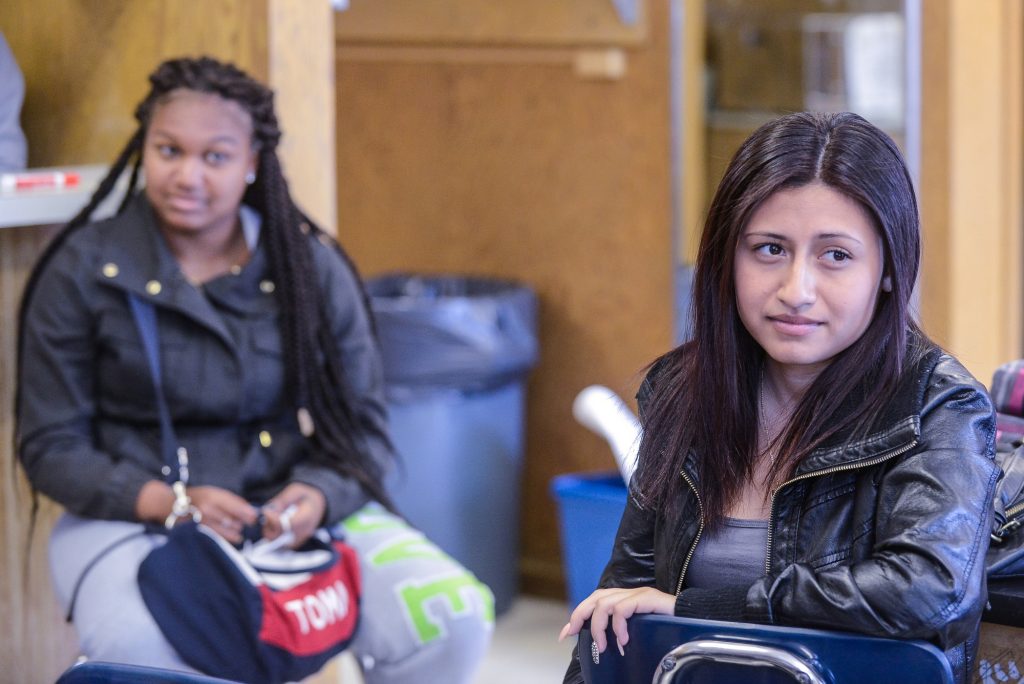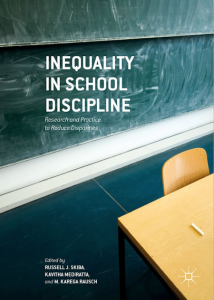Why are some students subjected to harsher discipline than others? How can we fix this problem?
Resource type: News
Kavitha Mediratta and M. Karega Rausch |

 This post is an excerpt from Kavitha Mediratta and M. Karega Rausch’s introduction to Inequality in School Discipline, a new book that fills a critical void by providing the most current and authoritative information on what is known about disciplinary disparities.
This post is an excerpt from Kavitha Mediratta and M. Karega Rausch’s introduction to Inequality in School Discipline, a new book that fills a critical void by providing the most current and authoritative information on what is known about disciplinary disparities.
Our country recently witnessed the profound and life-altering consequences students face when engaging punitive disciplinary systems. Sitting quietly at her desk at Spring Valley High School in Columbia, South Carolina, Shakara—a Black female teenager—was grabbed, thrown on the ground and then dragged across the classroom and arrested by a White male school resource officer for failing to comply with instructions to put away her cell phone (Jarvie, 2015; Savali, 2015). The incident, which was captured on video, left Shakara facing misdemeanor charges for “disturbing schools,” a charge that carries a $1,000 maximum fine and up to 90 days in jail, as well as a broken arm and injuries to her face, neck, ribs, back, and left shoulder.
While Shakara’s case sparked national outrage, including an investigation from the U.S. Department of Justice, it is one of many examples of the excessive and racialized overuse of punitive discipline common in schools. Data from the U.S. Department of Education show that Black students, who comprise 16% of overall student enrollment in U.S. public schools, make up more than a quarter of students referred to law enforcement from schools and 31% of those arrested for school-related incidents.
Nationally, 3.45 million students were suspended from school during the 2011-12 school year; among those students, Black students were three times more likely to be suspended and expelled than their White peers. Students with disabilities also face increased risk of exclusionary discipline; in 2012 they were twice as likely to be suspended as those without disabilities and represented a quarter of students arrested and referred to law enforcement, although they represented only 13% of the nation’s student population.
Data like these have been the subject of increasing concern to policymakers, civil rights advocates, parents, students, and scholars. Reflecting this growing national awareness, one news report on Shakara’s case observed:
“The aggressive discipline [in Spring Valley] is just one example of the school-to-prison pipeline phenomenon, in which Black children are more likely to be criminalized for their behavior than their White peers.”
Professional associations such as the American Psychological Association have issued reports on the ineffectiveness of and risks associated with disciplinary exclusion, particularly for Black students. Prominent school districts, such as the Los Angeles Unified School District, San Francisco Unified School District, and the New York City Department of Education, and states such as Colorado, Maryland, and California have revised their codes of conduct to focus on preventive alternatives to suspension and expulsion and curb the inequitable use of exclusionary discipline.
At the federal level, the U.S. Departments of Justice and Education led a national initiative on school discipline that resulted in federal civil rights guidance aimed at reducing the use of, and disparities in, suspension and expulsion, as well as expanded data collection and monitoring of disciplinary exclusion nationally. Federal agencies are also providing new funding for school climate interventions, research on best practices, and judicially led multi-stakeholder coalitions to reform policy and practice.
Yet, despite this growing sense of the need for a change and initial steps in some places to address the issue, the field lacks comprehensive analysis of why disciplinary exclusion and disparities have become so prevalent, and what can be done to reverse this trend.
Why are some students subjected to harsher discipline than others, and why are suspensions, expulsions, and arrests so widely used? What should we do to change these patterns in schools?
Inequality in School Discipline is intended to answer those questions by providing the most up-to-date and authoritative information on what has been learned from research, data, and practical experience about disciplinary disparities, and the latest findings regarding disparity-reducing approaches. We argue that there is a need to examine the roles of bias and inequality in educational and societal opportunities in the creation of disciplinary disparities in schools. In a context of increasing stakes for educational achievement, the work of disparity reduction could not be more important. Moreover, in light of growing evidence of disparate treatment on the basis of race by law enforcement authorities, we must explore how school-based authorities perceive and respond to youth behavior contribute to large and continuing disparities in school punishments.
Learn More
- Explore the table of contents below
- Learn more | buy the book
Get Involved
Table of Contents
Section I. Discipline Disparities: A Research-to-Practice Collaborative
Introduction
Kavitha Mediratta and M. Karega Rausch
Chapter 1 What Do We Know about Discipline Disparities? New and Emerging Research
Russell Skiba, Mariella Arredondo, Chrystal Gray, and M. Karega Rausch
Chapter 2 How Educators Can Eradicate Disparities in School Discipline
Anne Gregory, James Bell, and Micha Pollock
Section II. Understanding and Addressing Disparities: What We Are Learning and What We Can Do
Chapter 3 Sexual Orientation-Based Disparities in School and Juvenile Justice Discipline Practices: Attending to Contributing Factors and Evidence of Bias
Paul Poteat, Jillian Scheer, and Eddie S.K. Chong
Chapter 4 Does Teacher-Student Racial/Ethnic Congruence Predict Black Students’ Discipline Risk?
Jamilia Blake, Danielle Smith, Miner Marchbanks, Allison Seibert, and Eun Sook Kim
Chapter 5 Reducing Racial Disparities in School Discipline: Structured Decision-making in the Classroom
Aishatu Yusuf, Angela Irvine, and James Bell
Chapter 6 School-wide Positive and Restorative Discipline (SWPRD): Integrating School-wide Positive Behavior Interventions and Supports and Restorative Discipline
Claudia Vincent, John Inglish, Erik Girvan, Jeffrey Sprague, and Timothy McCabe
Chapter 7 Ecologies of School Discipline for Queer Youth: What Listening to Queer Youth Teaches Us About Transforming School Discipline
Boyd Bellinger, Nicole Darcangelo, Stacey Horn, Erica Meiners, and Sarah Schriber
Chapter 8 The Potential of Restorative Approaches to Discipline for Narrowing Racial and Gender Disparities
Anne Gregory and Kathleen Clawson
Chapter 9 Intersectional Inquiries with LGBTQ and Gender Nonconforming Youth of Color: Participatory Research on Discipline Disparities at the Race/Sexuality/Gender Nexus
Jennifer Chmielewski, Kimberly Belmonte, Brett Stoudt, and Michelle Fine
Chapter 10 Research and Training to Mitigate the Effects of Implicit Stereotypes and Masculinity Threat on Authority Figures’ Interactions with Adolescents and Minorities
Kimberly Barsamian Kahn, Phillip Atiba Goff, and Jack Glaser
Chapter 11 Discipline Disparities for LGBTQ Youth: Challenges That Perpetuate Disparities and Strategies to Overcome Them
Shannon Snapp and Stephen Russell
Chapter 12 From Punitive to Restorative: One School’s Journey to Transform Its Culture and Discipline Practices to Reduce Disparities
Marieka Schotland, Harriet MacLean, Karen Junker, and Jean Phinney
Section III. Conclusions and Implications
Chapter 13 Eliminating Excessive and Disparate School Discipline: A Review of Research and Policy Reform
Dan Losen and Leticia Smith-Evans
Conclusion Moving Towards Equity in School Discipline
Russell Skiba
The Discipline Disparities Collaborative is an Atlantic grantee.